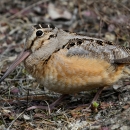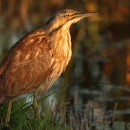
Many secretive marshbirds are difficult to detect, and existing avian survey methods (e.g., Breeding Bird Surveys) do not provide reliable estimates of population size or trends. Recently developed standardized survey protocols for secretive marshbirds provide a framework for evaluating responses of this group of birds to vegetation management and for assessing their distribution and abundance. In 2015 and 2016 we used the Standardized North American Marsh Bird Monitoring Protocol to evaluate differences in marshbird abundance and occurrence associated with different management strategies to control invasive wetland vegetation on public lands in west-central and northwestern Minnesota.
At our west-central Minnesota study area, we evaluated management histories from 2000 to 2014 to group wetlands into 4 treatment categories: low frequency fire (n = 48), moderate frequency fire (n = 31), high frequency management with fire and grazing (n = 34), and other high frequency management (i.e., frequent management through grazing, fire, or a combination of grazing and fire; n = 14). At each of these wetlands we conducted 2 marshbird surveys each year and characterized vegetation structure structure
Something temporarily or permanently constructed, built, or placed; and constructed of natural or manufactured parts including, but not limited to, a building, shed, cabin, porch, bridge, walkway, stair steps, sign, landing, platform, dock, rack, fence, telecommunication device, antennae, fish cleaning table, satellite dish/mount, or well head.
Learn more about structure and composition. We detected 596 birds of the 6 species for which we broadcasted vocalizations; sora (Porzana carolina) detections comprised 41% of all detections.
We observed only weak patterns in marshbird abundance related to treatment category, and are evaluating potential relationships between marshbird abundance and vegetation characteristics and other attributes of individual wetlands. At our northwestern Minnesota study area, we evaluated the effects of herbicide treatment on invasive cattails (Typha angustifolia and Typha x glauca) by conducting marshbird surveys at treatment locations (n = 9, with 28 survey points) before and after application, and at paired control sites (n = 9 with a total of 28 survey points). We detected 835 individuals of the 6 species for which we broadcasted vocalizations; 41% of detections were of American bitterns (Botaurus lentiginosus).
Our analyses of marshbird counts related to treatment (spray versus control) suggest no difference in marshbird abundance the spring following herbicide application. However, we caution that a response of marshbirds to herbicide application is likely to take more than a single season. Overall, we conclude that secretive marshbird abundance is likely more strongly related to vegetation and other characteristics of wetlands than to treatment with grazing and fire (Morris study area) and that marshbirds do not immediately respond to herbicide application to control invasive cattails (northwestern Minnesota study area).


